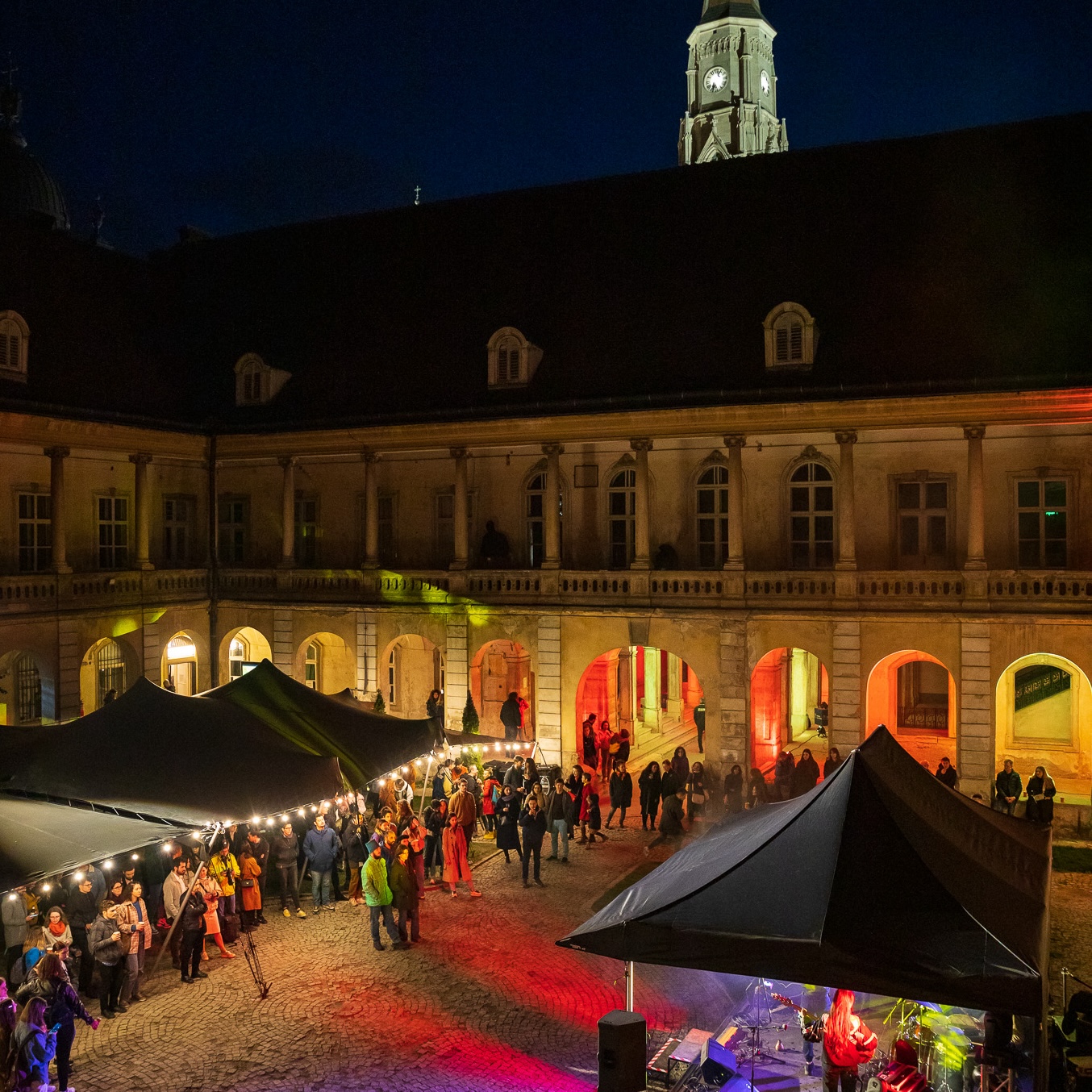ENESCU
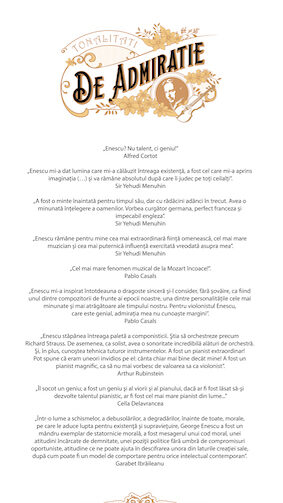
TONALITIES OF ADMIRATION
„Enescu? Not talent, but genius!” Alfred Cortot
„Enescu gave me the light that guided my entire existence, he was the one who ignited my imagination (…) and will remain the absolute by which I judge all others.” Sir Yehudi Menuhin
„He was a forward-thinking mind for his time, but with deep roots in the past. He had a wonderful understanding of people. He spoke fluent German, perfect French, and impeccable English.” Sir Yehudi Menuhin
„Enescu remains for me the most extraordinary human being, the greatest musician, and the most powerful influence ever exerted over me.” Sir Yehudi Menuhin
„The greatest musical phenomenon since Mozart!” Pablo Casals
„Enescu has always inspired me with sincere love, and I consider him, without a doubt, one of the leading composers of our time, one of the most wonderful and attractive personalities of our time. For the genius violinist Enescu, my admiration knows no bounds.” Pablo Casals
„Enescu mastered the entire range of composition. He knew how to orchestrate like Richard Strauss. Also, as a soloist, he had an incredible sound alongside the orchestra. And besides, he knew the technique of all instruments. He was an extraordinary pianist! I can say that I was sometimes envious of him: he played even better than me! He was a magnificent pianist, not to mention his value as a violinist.” Arthur Rubinstein
„I consider him a genius; he was a genius of the violin and the piano. If he had been allowed to develop his piano talent, he would have been the greatest pianist in the world…” Cella Delavrancea
„In a world of divisions, disorientation, and degradation, primarily moral, brought about by the struggle for existence and survival, George Enescu was a proud example of moral steadfastness. He was a messenger of a moral code, an attitude full of dignity, a political stance without a hint of opportunistic compromises, an attitude that can help us decipher some aspects of his creation, as well as serve as a model of behavior for any contemporary intellectual.” Garabet Ibrăileanu
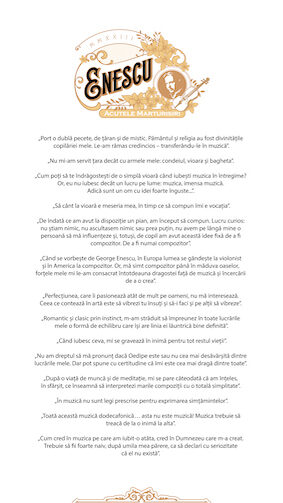
ENESCU. THE SHARPNESS OF CONFESSION
„I bear a dual seal, that of a peasant and a mystic. The land and religion were the divinities of my childhood. I remained faithful to them – transferring them into music.”
„To live, to breathe, to think – I have the feeling, or illusion, that I have done all these through music.”
„I’ve served my country with my own weapons: the pen, the violin, and the conductor’s baton.”
„How can you fall in love with a simple violin when you love music as a whole? Well, I only love one thing in the world: music, immense music. In other words, I am a person with very narrow ideas…”
„To play the violin is my profession, while to compose is my vocation.”
„As soon as I had access to a piano, I started composing. Curious thing: I knew nothing, hadn’t listened to much or anything, there was no one around me to influence me, and yet, as a child, I had this fixed idea of being a composer. Only a composer.”
„When George Enescu is mentioned, in Europe people think of a violinist, and in America, a composer. Yet, I feel like a composer to the core of my being; I’ve always dedicated my energies to my love for music and my attempt to create it.”
„Perfection, which so captivates people, doesn’t interest me. What matters in art is that you vibrate yourself and make others vibrate too.”
„A romantic and classic by instinct, I’ve strived to merge in all my works a form of balance that has its well-defined inner line.”
„When I love something, it’s engraved in my heart for the rest of my life.”
„If I could put on paper everything I have in my mind, it would take hundreds of years.”
„I don’t have the right to say whether Oedipe is my most perfect work or not. But I can say with certainty that it’s my dearest of all.”
„I’m never fully satisfied: never! If I were one day, I’d stop composing, from that very moment, to make such a wonderful moment eternal!”
„After a lifetime of work and meditation, sometimes it seems to me that I’ve finally understood what it means to interpret the great compositions with complete simplicity.”
„In music, there are no prescribed laws for expressing feelings.”
„All this dodecaphonic music… that’s not music! Music must go from one heart to another.”
„As I believe in the music I’ve loved so much, I believe in God who created me. You must be very naive, in my humble opinion, to declare seriously that he doesn’t exist.”
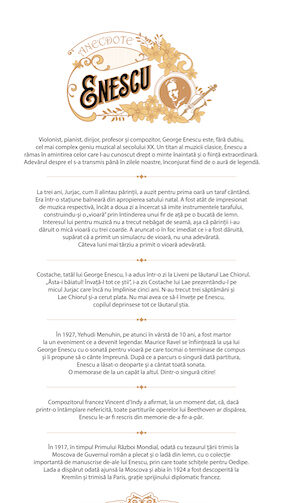
ENESCU, A STORY OF GENIUS
Violinist, pianist, conductor, teacher, and composer, George Enescu is undoubtedly the most complex musical genius of the 20th century. A titan of classical music, Enescu remains in the memories of those who knew him as an advanced mind and an extraordinary being. The truth about him has been passed down to our days, surrounded by an aura of legend.
At the age of three, Jurjac, as his parents called him, heard a taraf (a type of folk ensemble) playing for the first time. It was in a spa near his hometown. He was so impressed by the music that the next day he tried to imitate the instruments of the taraf, constructing his own „violin” by stretching a thread over a piece of wood. His interest in music didn’t go unnoticed, so his parents gifted him a small three-stringed violin. He immediately threw it into the fire, upset that he received a fake violin, not a real one. A few months later, he received a real violin.
Costache, George Enescu’s father, brought him one day to Liveni to meet the folk musician Lae Chiorul. „This is the boy! Teach him everything you know,” Costache told Lae, presenting young Jurjac, who hadn’t yet turned five. Three weeks later, Lae Chiorul asked for payment. He had nothing more to teach Enescu, as the child had learned everything the folk musician knew.
In 1927, Yehudi Menuhin, then 10 years old, witnessed a legendary event. Maurice Ravel showed up at George Enescu’s door with a violin sonata he had just finished composing and proposed that they play it together. After quickly going through the score once, Enescu set it aside and played the entire sonata. He had memorized it from beginning to end. From a single reading!
The French composer Vincent d’Indy once stated that if, by some unfortunate chance, all the scores of Beethoven’s works were to disappear, Enescu could rewrite them from memory, note by note.
In 1917, during World War I, along with the country’s treasury sent to Moscow by the Romanian Government, a wooden chest containing an important collection of Enescu’s manuscripts, including all the sketches for „Oedipe,” also departed. The chest disappeared once it reached Moscow, and only in 1924 was it discovered in the Kremlin and sent to Paris, thanks to French diplomatic support.
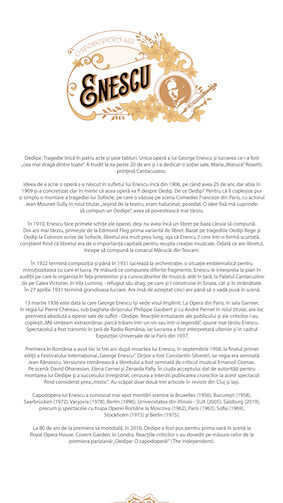
ENESCU’S MASTERPIECE
Oedipe. A lyrical tragedy in four acts and six scenes. George Enescu’s only opera and the work he held „dearest of all.” He labored over it for over 20 years and dedicated it to his wife, Maria „Maruca” Rosetti, Princess Cantacuzino.
The idea of writing an opera was born in Enescu’s heart as early as 1906, when he was 25 years old, but it wasn’t until 1909 that he clearly conceived in his mind that the opera would be about Oedipus. Why Oedipus? Because he had been overwhelmed by a staging of Sophocles’ tragedy, which he had seen on the stage of the Comédie-Française in Paris, with actor Jean Mounet-Sully in the titular role. „Leaving the theater, I was hallucinating, possessed. An obsession seizes me: to compose an Oedipus,” he would later recount.
In 1910, Enescu made the first sketches of the opera, although he didn’t yet have a libretto on which to compose. Two years later, he received the first version of the libretto from Edmond Fleg. Based on Sophocles’ tragedies Oedipus Rex and Oedipus at Colonus, the libretto was much too long, so Enescu requested a shortened form, fully aware that the libretto was crucial for the success of the musical creation. Once he had the libretto, he began composing at Maruca’s estate in Tescani.
He completed the composition in 1922 and worked on the orchestration until 1931, a situation emblematic of the meticulousness with which he worked. As he composed different fragments, Enescu would perform them on the piano in auditions organized for friends and music connoisseurs, both in the country, at the Cantacuzino Palace on Calea Victoriei, and at Villa Luminiș – his beloved refuge he had built in Sinaia, as well as abroad. On April 27, 1931, he finished the grand work. However, he had to wait five more years to see it staged.
March 13, 1936, is the date when George Enescu sees his dream come true. At the Paris Opera, in the Garnier hall, under the direction of Pierre Chéreau, conducted by Philippe Gaubert, and with André Pernet in the titular role, the absolute premiere of his beloved work – Oedipe – takes place. The enthusiastic reactions of the audience and critics overwhelmed him. „I felt extraordinary, as if I were living in a dream or a legend,” Enescu later said. The performance was broadcast in the country by Radio Romania, and the work was subsequently performed at the 1937 Paris Universal Exhibition.
The premiere in Romania took place three years after Enescu’s death, in September 1958, at the end of the first edition of the „George Enescu” International Festival. The conductor was Constantin Silvestri, and the direction was signed by Jean Rânzescu. The Romanian version of the libretto was signed by music critic Emanoil Ciomac. On stage: David Ohanesian, Elena Cernei, and Zenaida Pally. Despite the authorities’ approval for staging Oedipe and its success, censorship banned the publication of reviews for this performance, as it was considered too „mystical.” Only two or three articles in magazines from Cluj and Iași managed to escape censorship.
Enescu’s masterpiece later saw stagings in Brussels (1956), Bucharest (1958), Saarbrücken (1972), Warsaw (1978), Berlin (1996), University of Illinois – USA (2005), Salzburg (2019), as well as performances with the Romanian Opera troupe in Moscow (1962), Paris (1963), Sofia (1969), Stockholm (1975), and Berlin (1975).
On the 80th anniversary of its world premiere in 2016, Oedipe was staged for the first time at the Royal Opera House, Covent Garden, in London. Critics’ reactions proved to be as favorable as those at the Parisian premiere: „Oedipe: A Masterpiece!” (The Independent).
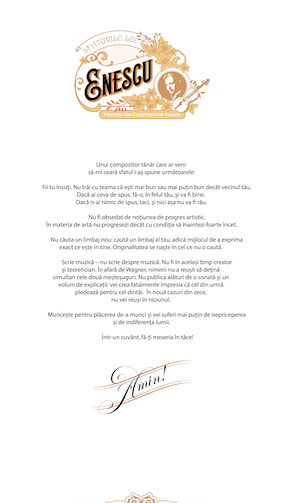
ENESCU’S ADVICE FOR A YOUNG COMPOSER
To a young composer who would come to ask for my advice, I would say the following:
Be yourself. Don’t live in fear of being better or worse than your neighbor. If you have something to say, say it in your own way, and it will be fine. If you have nothing to say, be silent, and even then it won’t be bad.
Don’t be obsessed with the notion of artistic progress. In matters of art, you only progress if you move forward very slowly.
Don’t seek a new language: seek your own language, meaning the means to express exactly what is within you. Originality is born in the one who doesn’t seek it.
Write music – don’t write about music. Don’t be both a creator and a theoretician at the same time. Besides Wagner, no one has succeeded in simultaneously mastering both crafts. Don’t publish a volume of explanations alongside a sonata: you will inevitably create the impression that the latter pleads for the former. In nine cases out of ten, you will not succeed in either.
Work for the pleasure of working, and you will suffer less from the world’s lack of understanding and indifference.
In short, do your job in silence.
Amen!
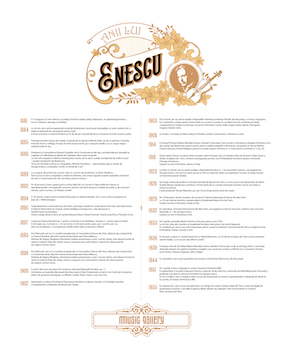
YEARS OF GEORGE ENESCU
1881
On August 19, in Liveni-Vârnav, in the Dorohoi County (now Botoșani County), George Enescu is born, the son of Costache, a tenant farmer, and Maria.
1884
At the age of three, he has a decisive musical experience when he accidentally hears a taraf (folk music ensemble) playing in a spa near his hometown. The next day, he creates his first violin using a thread stretched over a piece of wood and tries to imitate the music he heard.
1885
He receives his first notions of musical notation from engineer Mihail Zoller, and from his father Costache, he learns theory and solfeggio. He begins to play by ear on a single string with a single finger, performing melodies heard in the village.
1886
Professor and composer Eduard Caudella from the Iași Conservatory recognizes the child’s exceptional talent and advises his parents to guide him towards musical studies.
At the age of five, he successfully plays his first complete violin piece, accompanied by Zoller on the piano – Beethoven’s „Spring Sonata.”
He also completes his first composition: „Pământ Românesc – opera for piano and violin, by George Enescu, Romanian composer, aged 5.”
1888
Little Jurjac, as his parents nicknamed him, goes to Austria for musical studies, accompanied by his mother. On October 5, he enrolls at the „Konservatorium für Musik und darstellenede Kunst al Gesellschaft der Musikfreunde in Wien,” becoming the second child under the age of 10 to be accepted at the prestigious institution after Fritz Kreisler (1882).
He studies here for six years, with teachers including Siegmund Bachrich and Josef Hellmesberger Jr. (violin), Ernst Luswig (piano), and Robert Fuchs (harmony, counterpoint, composition).
1889
On August 5, he gives his first concert, a charity event, in Slănic-Moldova.
During this year, he also becomes acquainted with Johannes Brahms, who regularly attends rehearsals of the Conservatory’s student orchestra, in which Enescu plays.
1892
On January 26, Enescu performs in a concert before the Viennese audience for the first time, at the Bösendorfer Hall. More concerts follow, and his talent is immediately recognized by the Vienna public and critics, who call him „A Romanian Mozart.”
1894
On March 20, he gives his first recital in Bucharest, at the Romanian Athenaeum. At the age of 13, he performs alongside J. Hellmesberger on the piano.
1895
After graduating from the Vienna Conservatory, he begins his studies at the Paris Conservatory under the guidance of Martin Pierre Marsick (violin), André Gédalge (counterpoint), Jules Massenet, and Gabriel Fauré (composition). His Parisian colleagues include Maurice Ravel, Florent Schmitt, Charles Koechlin, and Theodor Fuchs.
On May 3, he completes his School Symphony No. 1 in D minor.
1896
On March 26, he performs the Violin Concerto in the famous Pleyel Hall in Paris.
1897
He composes Romanian Poem op. 1 for orchestra and male chorus, Sonata No. 1 for piano and violin in D major, op. 2, and Suite No. 1 in old style for piano, op. 3. These works bring him recognition.
He meets Camille Saint-Saëns and Édouard Collone.
1898
On February 6, under exceptional circumstances, his compositional debut takes place at the Colonne Concerts in Paris, featuring the Romanian Poem, partly due to his protector Elena Bibescu.
On March 13, in the Romanian Athenaeum, the 17-year-old leads the Philharmonic Society Orchestra, conducting the Romanian Poem. This is just one of the many recitals he performs that year in Romania.
Admired by Queen Elisabeth of Romania (a famous art patron, Carmen Sylva), he is often invited to play at Peleș Castle in Sinaia. Enescu composes several lieder inspired by poems written by Queen Carmen Sylva.
1899
On July 24, he completes his violin studies at the Paris Conservatory, receiving the first prize and a violin with his name inscribed on it.
1900
In the first two years of the 20th century, he composes the two Romanian Rhapsodies, op. 11.
His musical activity alternates between Bucharest and Paris. He undertakes tours across several European countries, performing alongside prestigious partners such as Alfredo Casella, Pablo Casals, and Louis Fournier.
1902
He debuts as a soloist with the Berlin Philharmonic Orchestra and becomes a member of the Society of Authors, Composers, and Music Publishers in France.
1903
On March 8, the first performance of the Romanian Rhapsodies takes place at the Romanian Athenaeum in Bucharest, conducted by Enescu.
On November 6, he performs his first concert in London.
Over the next years, he has intensive compositional activity and performs numerous concerts in Romania, France, Italy, England, Russia, Spain, Portugal, Hungary, and the United States.
1908
In Sinaia, he meets Maria „Maruca” Rosetti, Princess Cantacuzino, his future wife.
1909
On March 2, his mother, Maria Enescu, passes away.
1910
He begins making the initial sketches for the opera „Oedipe,” even though he does not yet have a libretto to work with.
1913
In March, he donates 27,000 lei to the Ministry of Public Education to establish the George Enescu Fund for composition awards. The first jury meets on October 28 and 29.
1914
During World War I, Enescu stays in Bucharest. He performs concerts in Romania, conducts Beethoven’s Ninth Symphony (the first complete performance in Romania), compositions by Hector Berlioz, Claude Debussy, Richard Wagner, as well as his own works: Symphony No. 2 and Suite No. 2, op. 20.
1915
On January 1, he performs Chausson’s Poem in its premiere in Bucharest, accompanied on the piano by Cella Delavrancea.
He gives concerts at the Romanian Athenaeum and donates 30,000 lei for the purchase of an organ.
1916
He performs concerts for wounded soldiers at the Athenaeum and in hospitals.
On June 8, he is elected an honorary member of the Romanian Academy.
1918
After the war, Enescu continues his series of tours across Europe and the United States. He conducts prestigious orchestras, including the Philadelphia Orchestra, Boston Orchestra, and Chicago Symphony, starting in 1923.
1919
On December 23, his father, Costache Enescu, passes away.
1921
On December 8, he conducts Wagner’s „Lohengrin” at the inauguration of the Romanian State Opera in Bucharest.
He undertakes tours in Romania and the Netherlands.
1922
On November 19, he performs piano pieces from the opera „Oedipe” at the residence of Princess Maria Cantacuzino.
He embarks on tours in Romania, Spain, and France.
1923
In Paris, in March, the first performance of Romanian Rhapsody No. 1 takes place at the Colonne Concerts, conducted by George Enescu.
He embarks on his first major tour in the USA as a violinist, conductor, and composer.
In June, in Sinaia, he begins orchestrating the opera „Oedipe.”
1924
In January and February, he embarks on his second major tour in the USA.
On November 17, he signs the establishment act of the Society of Romanian Composers in Bucharest.
On December 7, the Bucharest Philharmonic Orchestra performs the Theban Dances from „Oedipe” for the first time, conducted by the composer.
In the following three years, he composes, undertakes tours in the USA, France, Spain, Portugal, Romania, and holds several conferences on Romanian music and concerts with Nicolae Caravia, Marcel Clampi, and Maurice Ravel.
1928
He begins his teaching career at the Paris Normal School of Music with five courses on interpretation focusing on Bach, Vivaldi, Mozart, Beethoven, and Brahms. Among his students are violinists Christian Ferras, Ivry Gitlis, and Arthur Grumiaux.
He is introduced to Yehudi Menuhin and gives him violin lessons in Sinaia.
1929
On February 10, he becomes an honorary member of the International House Club in New York.
On May 18, he becomes a corresponding member of the Academy of Fine Arts in Paris.
He embarks on tours in Romania, France, and the USA.
1931
He is appointed an honorary member of the Santa Cecilia Music Academy in Rome and receives the gold medal from the Society of Arts and Letters in Paris.
On April 27, at Tescani, he completes the opera „Oedipe,” with a libretto by Edmond Fleg, dedicated to Maria Rosetti.
On September 27, he is elected honorary rector of the Academy of Music in Bucharest.
On December 11, a jubilee concert is held for George Enescu at the Romanian Athenaeum, and he is declared an honorary citizen of Bucharest.
On December 21, accompanied by the Paris Symphony Orchestra, he performs Bach’s Concerto for Two Violins and Orchestra with Yehudi Menuhin.
He embarks on tours in Romania, Spain, and Portugal.
1932
In November, the New York Philharmonic Orchestra, under the baton of Arturo Toscanini, performs George Enescu’s Romanian Rhapsody No. 1 in five concerts.
He embarks on tours in Romania and the USA.
1933
On April 3, he receives the Grand Prize of the Record for 1933.
On May 22, he is elected a member of the Romanian Academy, replacing Iacob Negruzzi.
Over the next years, he gives interpretation courses for violin in England and Italy and conducts the BBC Symphony Orchestra twice in London.
1936
In January, he performs a recital with Yehudi Menuhin.
On March 10, the premiere of the opera „Oedipe” takes place at the Paris Opera, receiving a resounding success.
On March 13, he receives the Order of the Legion of Honor, in the rank of Commander, from the Ministry of the Arts in Paris.
In November, he is declared an honorary citizen of Iași.
He embarks on tours in Romania, France, Belgium, and the USA.
1934
On February 4, he becomes a member of the Academy of Arts and Sciences in Prague.
On October 28, he receives the Grand Prize of the International Exhibition in Paris.
On December 4, he marries Maria Rosetti, Princess Cantacuzino, in Bucharest.
Five days later, he performs a concert with Pablo Casals in Bucharest, after which he resumes his series of tours in Romania, France, and Belgium that will last for several years.
1939
During World War II, Enescu stays in Bucharest, where he distinguishes himself with intense conducting activity, while also encouraging the creations of Romanian musicians like Mihail Jora, Constantin Silvestri, Ionel Perlea, Theodor Rogalski, and Sabin Drăgoi.
1944
In November, he is appointed honorary president of the Bucharest Philharmonic Orchestra.
1946
In April, he undertakes a tour in the USSR, where he interacts with musicians Dmitri Shostakovich, Aram Khachaturian, Kiril Kondrashin, David Oistrakh, and Lev Oborin.
In May, he receives a visit from Yehudi Menuhin in Bucharest.
In September, he embarks on a tour in the United States with his wife. After returning to Europe, he settles in Paris due to the establishment of the communist regime in Romania.
1947
He performs many concerts together with Menuhin in France, Belgium, Switzerland, the USA, and England.
1950
On January 21, he performs with Yehudi Menuhin and the Metropolitan Opera Orchestra at Carnegie Hall in New York, conducted by Ionel Perlea.
He gives interpretation courses in England and undertakes a final tour in the USA.
1951
On April 7, Enescu conducts the BBC Orchestra in London.
In September, he grants a series of 20 interviews to Bernard Gavoty, broadcast by French Radio and later published in the book „Amintirile lui George Enescu” („The Memoirs of George Enescu”).
In the following years, he conducts interpretation courses for violin on masterpieces in England and Italy and conducts the BBC Symphony Orchestra in London twice.
1954
On the night of July 13-14, he suffers a stroke in his apartment on Clichy Street in Paris, which paralyzes half of his body.
1955
On the night of May 3-4, George Enescu passes away at the Atala Hotel in Paris, where he was cared for by its owner. His loyal dog, Mutzerli, remains by his side until the end. He is buried in the Père Lachaise Cemetery in Paris.
